
![]()
~ THE BUTTERMARKET / BULLSTAKE ~
CANTERBURY
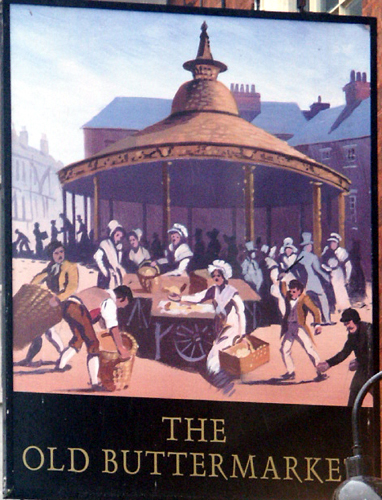
1645. The market-cross, at the Bull-stake, is taken down. Hasted
1664. The building erected by Mr. Somner, over the market-place, at the Bullstake, is finished. Hasted
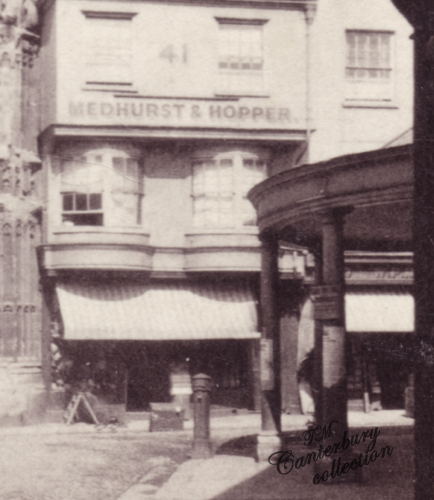
"..and presently after we see our Butter-market, with a house over it, supported by handsome pillars of oak." A Walk in and about the City of Canterbury 1825
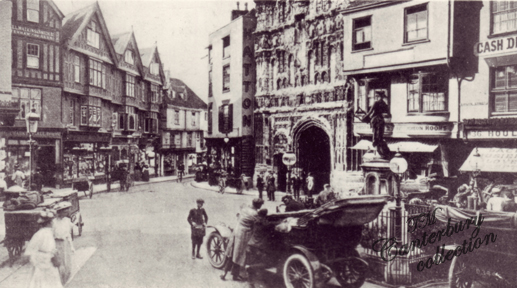
A view of the Butter Market area from my old postcard, notice the Marlowe Memorial is still there, and the Cathedral Gate has not been repaired yet, this is also after the fire of the 1890's as the new buildings on Sun street have been erected
"In 1367 the market for the sale of Poultry, &c., extended from Christ Church great gate by the Bolstake, to Angel, now Butchery Lane." Felix Summerly
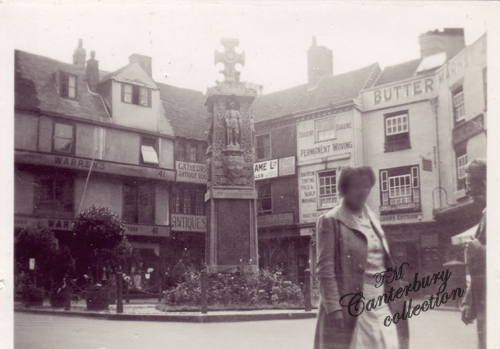
A view of the Buttermarket c. 1935 with the War Memorial in the background (an old photo from my collection)
You'll also notice Warrens Shirtmakers at no. 41 on the left and beside it Cathedral Antique Room
The building directly on the right of the War Memorial has signage on it as follows ...AME Ltd. ALES another sign says FREE HOUSE, then KENT'S BEST ALES & STOUT
The building just behind the woman to the left says Eugene, Permanant Waving, Hair Dyeing, Tinting, Face & Scalp Massage, Violet Ray & ......
The building on the right is the Buttermarket Stores, the signage on the immediate right of the woman says "Goods Entrance", and on the window box above it "Open on Sunday's"
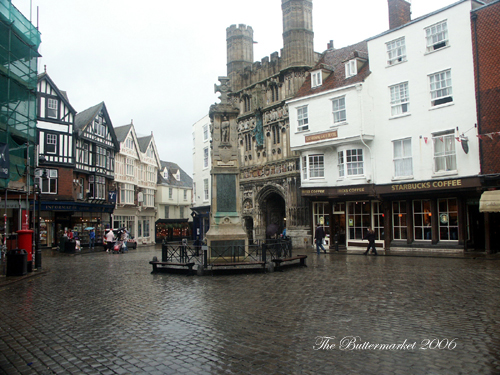
My photo of the Buttermarket showing Christ Church Gate and the War Memorial
1688. Thomas Turner, gent. makes a present of the city of one great light or lucidary, such a one as is in Cheapside, London, with all the iron-work and materials therof, which is to be fixed at the Bull-stake, and lighted with oil, for the general benefit of the inhabitants. (Hasted)
The Old Buttermarket, before it was torn down
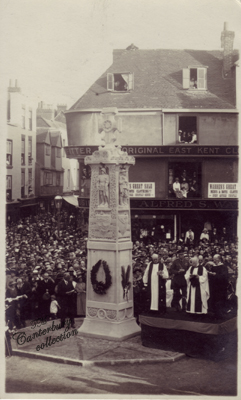
The unveiling of the war memorial in the Buttermarket, from my collection
The Market-Cross at the Bull-Stake, as it is usually called, built by John Coppyn of Whitstabel, and William Bigg of Canterbury, but pulled down by Mr. John Pollen, the Mayor of this City in 1645, to coin the Lead into Farthings. However in the same place is there a Market held twice a Week, viz. on Wednesday and Saturday plentifully serving the City and Neighbouring Parts with all sorts of Provisions, especially Poultry, for which it seems it was famous in ancient Times; the Place where that Market was kept retaining the Name of the Poultry, or le Polettria; for anciently the Market for divers Goods was kept in divers Places, as without Burgate in St. Paul's Parish, the Wheat Market; at the Red wall by the Archbishop's Palace Back gate, the Rush-market in St. George's Street, the Cloth-Market, and a little below it, the Flesh-Market or Shambles for Butchers Wares; in the High Street by St. Mary Bredman's Church, the Fish Market;.....
Magna Britannia Antqua & Nova 1738
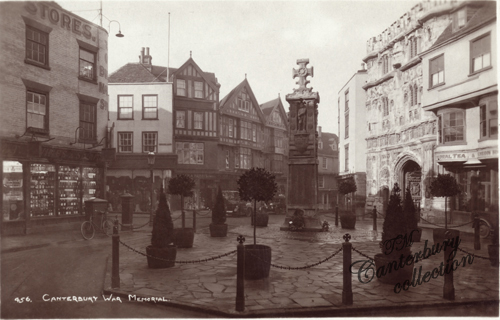
The war memorial in the Buttermarket, from my collection
"We may imagine the confusion, riot, and clamour, in such places as the "Butter Market," once denominated the "Bull's Stake," when one bull was baited after another by the butchers; the meat of these animals, by order of Burghmote, not being allowed to be sold unless the bull had been baited previously to his being slaughtered. Now and then an infuriated animal broke from the stake, carrying terror and confusion before him as he franticly rushed through the narrow thoroughfares of the Mercerie, followed by shouting butchers and by yelling dogs, scarcely less savage or brutal than their masters."
Canterbury in the olden time, John Brent
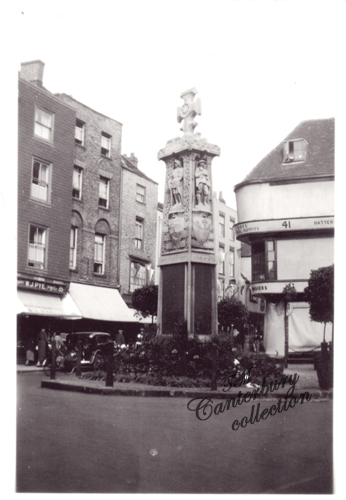
An old photo of the Buttermarket & War Memorial in my collection c. 1935
The building on the right is 35 Burgate W. J. Pye, Jeweller, Souveneirs
"There was a gibbet at the Bullstake upon which one of the Mayors of the city, Nicholas Faunt, is said to have been executed for taking part with the insurgent Falconbridge."
Canterbury in the olden time, John Brent
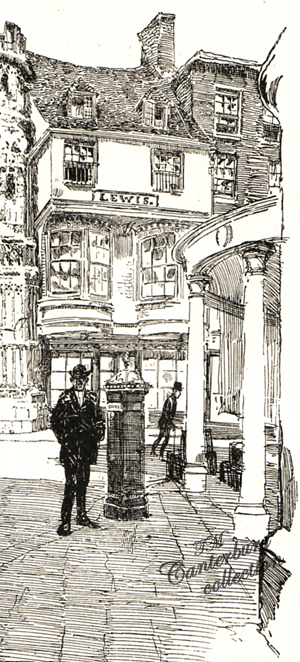
Christ Church Gate from Mercery Lane, you can just see the Old Buttermarket canopy on the right of the drawing c. 1887. You can see the William "Lewis" Shop in the background, that was there from at least 1887 to late 1880's. Also notice the Old Post Box.
The Covered Buttermarket was removed in 1888
"A.D. 1521, we have the following estimate of the services of a Canterbury artist, in ornamenting the Market Cross:
Item, paied to Floraunce, the paynter, by the grete, for the workmanship thereof, he fyndyng all maner of stuff to the payntyng of the Crosse except gold and bise, and gylding of the Stars...... VIII s. VIII d.
Doubtless this cross, which seems to have been highly ornamented as far as stars and paint and gold could make it, stood in the locality of the present Butter Market; although we have records of ancient crosses at the bottom of St. Margaret's street, St. Paul's and at Oaten-hill." Cot, JB
"The Butter Market occupies the site of the ancient bull-stake and market cross, near the cathedral gate. It consists of an oval roof with two lights in the centre, and is supported by cast iron pillars. The butchers of this city used formerly to amuse themselves and their neighbours by baiting their bulls at the Bull-stake, (now the Butter Market), in order to soften down the toughness of their flesh." Directory 1847
"In 1891 a bronze statue of a muse was erected in the Old Butter Market, to commemorate the tercentenary of the poet Christopher Marlowe, who was born in this city in 1564, and died at Deptford, 1 June, 1593."
 ____
____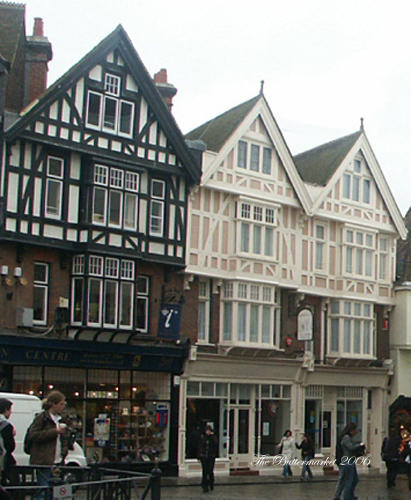
"Buttermarket" a detail from my old postcard, and a recent view of the same buildings from my photograph
1840's
William AUSTEN, Tailor
Thomas HARRIS, Victualler
Jacob BROOKES, Cork Cutter, Buttermarket
Harriet TERRY born 1825 in Kent was working for Jacob in the 1840's
*1843 Edward TURMAINE of the city of Canterbury, porter and ale merchant, d. c. - Official assignee, Gibson, Basinghall street. Sols. Barrun & Cullen, Bloomsbury square. Fiat, March 18. Pet. Cr. Jacob Brooks, of Canterbury, Cork Cutter
1870's 38 Butter Market - George P. LADD, Stationer & Book Seller
Died at Canterbury (July), Mr. S. Gardener. His death was occasioned by his being unfortunately drawn under the wheels of one of the Dover coaches which was passing the Buttermarket, and the wheel going over his loins, injured him so materially as to bring on his dissolution. He was eminent as a linguist, and enjoyed a remarkably sound state of health for his advanced age. - The Monthly Magazine 1801 pg. 560
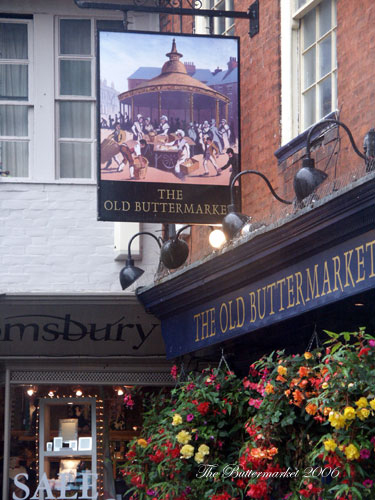
"The Buttermarket" my photo
The Buttermarket itself was built about 1789, and removed in 1888 (1891?). You can see a depiction of it in the sign hanging above in the photograph. Previous to this, the area was known as the "Bullstake" where the bulls were baited apparently to make the meat more tender. I'm sure they went directly to "Butchery Lane" after their slaughter.
1805-7
Edward GOLDFINCH, chemist and druggist